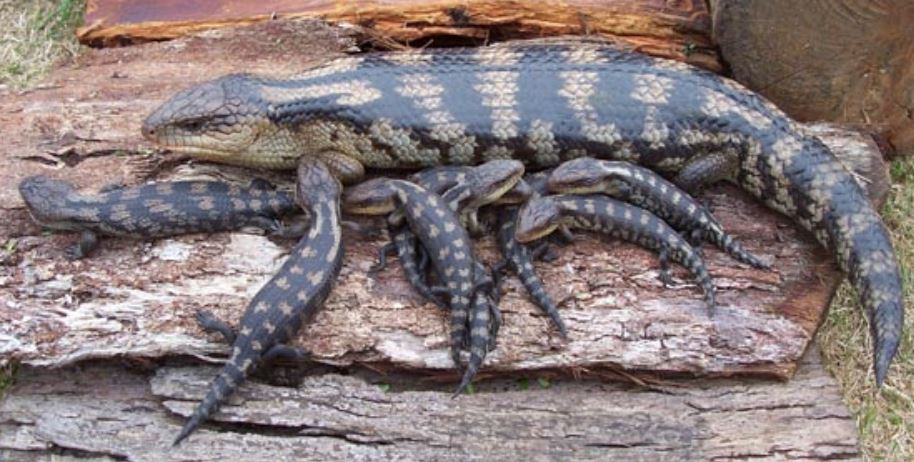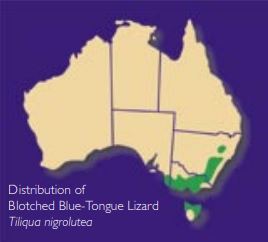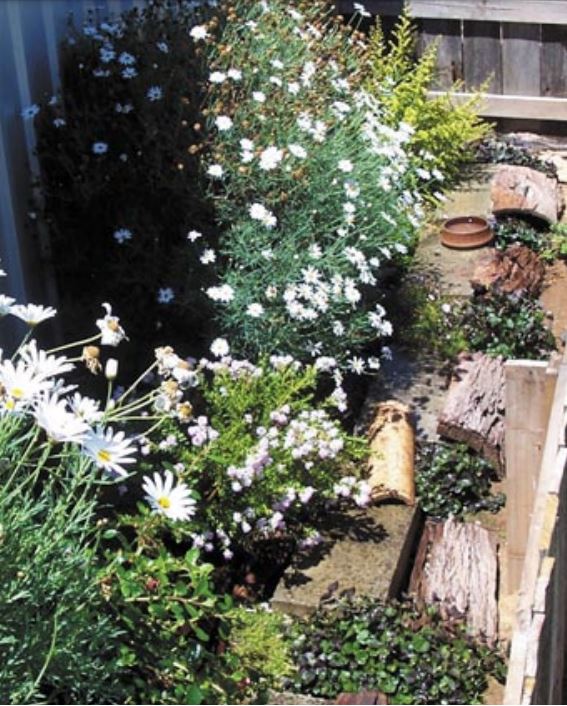Tassie snakes may be seen in surprising places, including towns and industrial areas, especially in summer when water is in short supply.
Do you know how to tell the difference between the three species of Tasmanian snakes, and what to do in an emergency?
- Types of Tasmanian Snakes
- ⚠️ First Aid for Snake Bite
- Encountering Snakes of Tasmania
- Contacts & Assistance with Reptiles*
- 💡 Tasmanian Snake Facts
- What to do if you find a snake at home
- Lizard or Snake?
- Roles and Values
- Habitat Loss
- First Aid for Reptiles
- Downloadable Snakes of Tasmania Guide + Safety & First Aid (PDF)
You will find a Downloadable Guide to the Snakes of Tasmania (including Emergency Numbers, First Aid, and Safety) at the bottom of this page. Please feel free to share the guide with attribution to Human Animal Science.
Types of Tasmanian Snakes
There are three types of snake species in Tasmania – the Tiger snake (Notechris scutatus), Copperhead (Austrelaps superbus) and White-lipped snake (Drysdalia coronoidies):
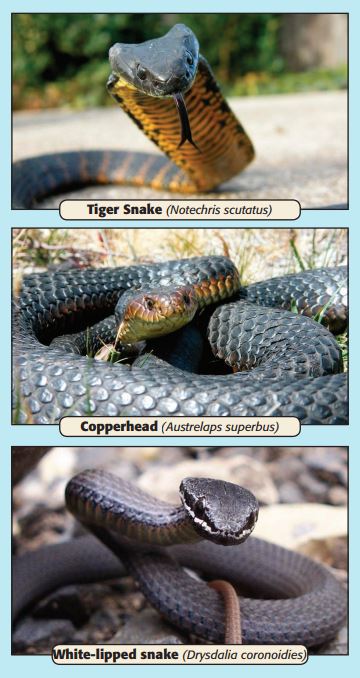
All three species of Tasmanian Snake are venomous.





⚠️ First Aid for Snake Bite

Snake bite is an acute medical emergency and it is important to act quickly and effectively.
In the event of a snake bite:
- Stay calm, safety comes first – check that the snake is not still near the victim.
- Keep the victim as still as possible and immediately apply a pressure bandage.
- Start the bandage over the bite site and continue to the end of the limb leaving fingers or toes exposed. Work back over the bite site to the top of the limb until the entire limb is covered. Immobilise the limb.
- Ring 000 for medical assistance.
- Mobile phones: ring 112 (please see important note under Contacts section below)
- Bring transport to the victim if possible, or carry the person on a makeshift stretcher. It is important that the person is kept as still as possible.
- Identification of the snake is unnecessary as the antivenom is effective for all three species of Tasmanian snakes.
- Once the pressure bandage is in place, treat the victim for shock; i.e. keep warm, monitor breathing and heart rate. Do not give food or drink.
- If person loses consciousness, place victim in coma position on the unaffected side and keep airways clear.
- Monitor fingers/toes – if they turn blue or white and go cold, the bandage is on too tight.
- Do not cut or suck the bite site.
- Do not release the bandage until victim has received advice from qualified medical practitioner.
⚠️ What not to do in the event of a snake bite!
- Do not apply a tourniquet
- Do not suck or cut a snake bite
- Do not attempt to catch the snake
- Do not let the victim walk about
Encountering Snakes of Tasmania
Snakes may be seen in the most surprising places including towns and industrial areas, particularly during summer when water is in short supply.
If possible, it’s always best to leave snakes alone.
Although most snakes will only be passing through, they do occasionally take up residence in suburban yards.
During prolonged dry periods, snakes are attracted to gardens in search of water, shelter and food (i.e. lizards, frogs, goldfish and mice/rats).
To minimise the presence of snakes around your home:
- Keep your lawns mowed.
- Minimise rubbish and garden waste.
- Stack wood away from the house.
- Do not have standing water in bowls or ponds close to the house.
If you have a pet dog or cat you must take extra precautions. Your pet cat may even bring a snake indoors to show it off to you – keep cat flaps closed!
Most people get bitten when they attempt to kill or handle a snake, or may have accidentally trodden on it. The last person to die from snake bite in Tasmania was bitten by a Tiger snake in 1966.
The best thing to do if you see a snake, is to stand very still and let it go on its way or if safe to do so, back away from it very slowly.
Contacts & Assistance with Reptiles*
North West Coast
Central North Wildlife Care & Rescue Inc: 0409 978 064
Statewide
DPIW Wildlife Management Branch: 1300 368 550 (or office hours only): 6233 6556
RSPCA: 1300 139 947
Emergency (Snake bites only): 000
Emergency Mobile Phones: 112
EMERGENCY MOBILE NO. IMPORTANT NOTE
If your carrier does not have service but another carrier does, the emergency number will automatically use that.
However, if there is no service at all in the area you won’t get through.
If you are going into the bush, always let someone know when you are leaving, due to return and where you are going.
Always carry an EPIRB and two bandages if you are going into remote areas.
* Please note: snake relocations will incur a fee
💡 Tasmanian Snake Facts
Below are a set of answers to commonly asked questions about the snakes of Tasmania.
- Tasmania has three species of snakes, the Tiger snake, Copperhead and White-lipped snake (formally known as whip snake), which are widely distributed throughout the State.
- All three types of Tasmanian snakes species are venomous.
- Snakes cannot regulate their body heat. They need to warm up in the sun, and become sluggish in cold weather.
- Snakes breed and birth in March/April and then go into hibernation for the winter, emerging in spring when temperatures warm up. Snakes will hibernate anywhere that is warm and dry and do not eat until they emerge from their torpor.
- Tasmanian snakes give birth to live young and do not lay eggs.
- Snakes generally give birth every second year.
- Copperheads give birth to 6–12 young; Tiger snakes between 20-30 and White-lipped snake approximately 2-6 young. Only a small percentage of the young survive to adulthood.
- Baby snakes are as venomous as adult snakes (just produce less venom).
- Snakes usually hide from the hot sun between 10am and 2pm, but will move around on cloudy days.
- Some snakes can live up to 30 years.
- Snakes will eat each other, frogs, tadpoles, lizards, small birds and marsupials, mice, rats and rabbits.
- Most snakes are good climbers and have been found in roofs and up trees.
- Tiger snakes and Copperheads are amongst the top 10 most venomous snakes in the world. Their venom is designed to quickly kill their prey in order to minimise the potential for injury to the snake.
- Both Copperhead and Tiger snakes have wide colour variations ranging from black to yellow, red and brown.
- Snakes are immune to their own venom.
- According to the records, no Copperheads have been responsible for any snake bite deaths in Tasmania.
What to do if you find a snake at home
If you find a snake on your property, make sure you take the following steps:
- Stay calm.
- Do not approach the snake. Secure children and pets safely away from the area.
- Keep the snake under constant observation if safe to do so, and ring for help.
Lizard or Snake?
The completely harmless lizard, the She-oak skink (Cyclodomorphus casuarinae) is only found in Tasmania and is often mistaken for a small snake.
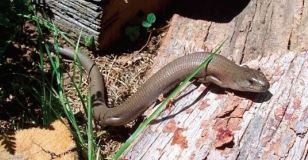
This is mainly because as well as flicking its tongue, it can tuck its legs and move along the ground with snakelike motion.
Roles and Values
Like most native mammals, birds and reptiles, Tasmanian snakes are protected by law.
They are an important source of food for the larger birds of prey and do an excellent job of controlling introduced pests such as rabbits, rats and mice which have a detrimental effect on farms and natural bushland.
Habitat Loss
Reptiles depend on native bush for their survival.
As more bushland is cleared for homes, agriculture and industry, animals have to adapt to the new environments to find food, shelter and breeding sites.
Unless areas can be reserved to provide habitat, snakes will be seen more often in gardens and urban areas.
First Aid for Reptiles
Snakes frequently get caught up in strawberry netting. If this happens, do not attempt to free them.
If it is a hot day, throw a towel over them, keep them shaded, cool and moist (light spray with water) and call an expert snake handler.
Bluetongues may also get caught in netting, and although they may bite it is more safe to attempt to free them yourself (with care).
Bluetongues may be injured by family pets or lawnmowers, or other items around the home or garden.
Related: Keeping Blue Tongue Lizards
Carefully scoop the animal into a secure cardboard box with a towel in the bottom to prevent sliding, and keep in a cool dark place and call wildlife rescue.
Injured snakes should only be handled by experts. Keep the snake under surveillance and ring for help from a handler.
Snakes on the Move!
Increasing day length and warmer temperatures in late spring tempt Tasmania’s snakes out of winter torpor.
All three Tasmanian species (Copperhead Austrelaps superbus, tiger snake Notechis scutatus and white-lipped snake Drysdalia coronoides) are now on the move.
While all are venomous, only tiger snakes have claimed human lives, although this was mainly before the development of antivenom in the 1930’s.
While Tasmania’s snakes have a reputation for aggression, most behaviour that people find threatening is largely bluff.
This is borne out by a very simple fact; in most rural areas snakes are present in very high densities, but bites to people are very rare.
Snakes will always retreat if given the opportunity to do so and even in very rare cases when tiger snakes feel sufficiently threatened to advance towards a person, they will not bite but veer away.
Most snake bites occur when people are attempting to capture or kill snakes.
If you see a snake at a safe distance simply walk away or around it.
If a snake is disturbed very close to you, the best thing to do (but also the hardest for many people) is to stay completely still.
With poor eyesight limited to about 1 meter, if you are not moving the snake will crawl passed you without being aware of your presence.
While the potential negative side of having snakes in your environment often receives plenty of press, the positives rarely do.
Tiger snakes have a very broad diet which includes introduced rodents such as mice, rats and juvenile rabbits.
These rodents are responsible for a lot of agricultural damage and few land owners appreciate the enormous numbers of these pests that snakes consume every year.
Copperheads also consume rats and mice but tend to specialise on frogs.
The ecological health of your dams, creeks and lagoons can be very quickly gauged by the presence or absence of healthy copperhead populations.
Without exception, high copperhead densities reflect high frog densities and high frog densities reflect a healthy ecosystem on your property.
While many land holders are not overly concerned by snakes away from homesteads and stock yards, there are a number of things you can do to deter snakes from choosing to take up residence close to human dwellings.
Most reptiles are very good at conserving water, mostly by absorbing moisture from prey and having a slow metabolism and scaly skin.
During dry weather, snakes often move closer to homesteads and urban areas in pursuit of prey such as frogs and rodents.
While snakes may not need lots of water in hot weather, their prey generally does.
Snakes can be discouraged by reducing cover for them as well as their prey.
Keep grass very short, stack timber, roofing iron etc well off the ground and away from residences and above all, eradicate rodent populations quickly. Nothing will encourage a large tiger snake around your house like an outbreak of rats.
While all Tasmanian snakes are protected, they can be destroyed if deemed a threat to people or livestock.
Given the many positives of having these snakes on your property, an alternative response should be considered.
There are a range of people around the state who will relocate the snake to a more remote part of your property without any of the risks of trying to kill the animal yourself
Downloadable Snakes of Tasmania Guide + Safety & First Aid (PDF)
The below guide to the Snakes of Tasmania (including Safety & First Aid) may be printed or shared. If sharing, please link to this page as the source.


